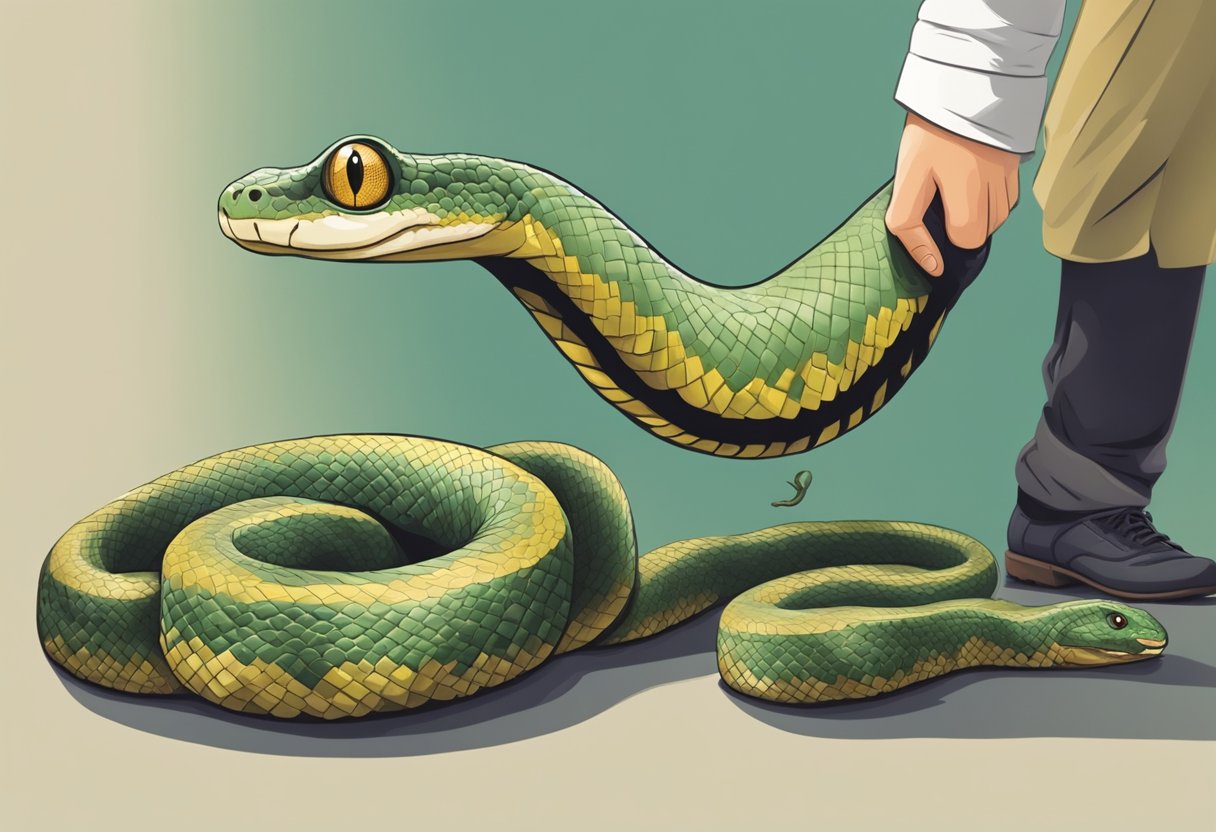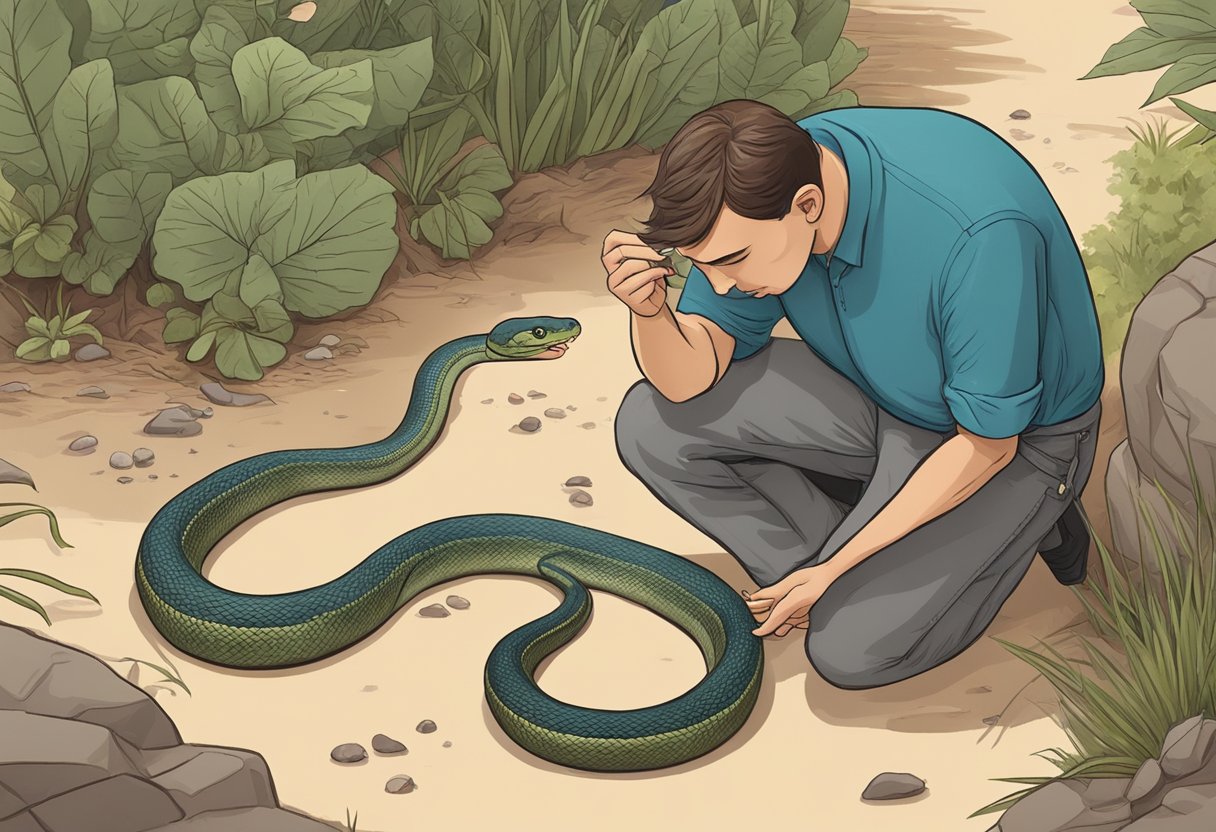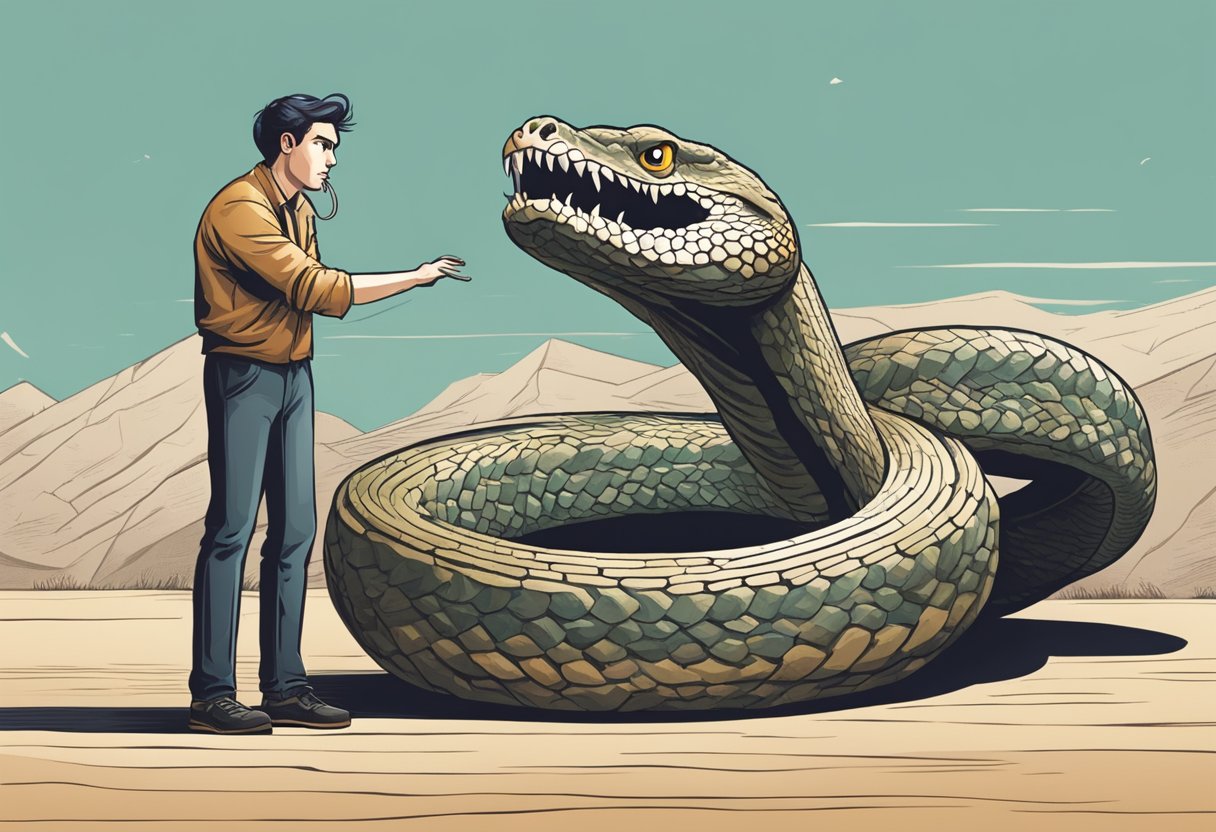Discover effective strategies for managing and reducing ophidiophobia, the fear of snakes, for greater peace of mind and well-being.
Table of Contents
Introduction – Ophidiophobia
Ophidiophobia is the term used to describe a severe and irrational fear of snakes that goes beyond normal caution or uneasiness. Those who suffer from it may experience an extreme emotional reaction even when encountering images or realistic representations of snakes, indicating that it is a specific type of phobia, rather than a broad fear of reptiles or other creatures. The distress associated with ophidiophobia can interfere with one’s daily life, limiting activities and experiences due to the persistent dread of coming into contact with snakes.

Despite the relatively low risk posed by snakes in everyday life, especially in urban settings, ophidiophobia remains a common anxiety disorder, affecting a significant portion of the population. This phobia, like other specific fears, can be attributed to various causes such as genetic predisposition, learned behaviors from family or peers, or a traumatic encounter with snakes. Recognizing the symptoms and understanding the nature of this phobia are the first steps towards seeking effective treatment, which may involve exposure therapy, cognitive behavioral therapy (CBT), or medication strategies aimed at controlling anxiety responses.
Key Takeaways
- Ophidiophobia is an intense, irrational fear of snakes that can impact daily activities.
- It is recognized as a specific phobia, targeting snakes specifically.
- Treatment options include therapy and medication to manage symptoms.
Understanding Ophidiophobia

Ophidiophobia, also known as ophiophobia, is a specific and intense fear of snakes often significant enough to affect a person’s daily life. It falls under the broader category of herpetophobia, the fear of reptiles.
Definition and Prevalence
Definition: Ophidiophobia is categorized as an anxiety disorder characterized by an overwhelming and irrational fear of snakes. While many individuals might feel uncomfortable around these reptiles, ophidiophobia describes a fear that goes far beyond mild concern.
Prevalence: It’s one of the most common zoophobias, affecting a substantial portion of the population. The exact number of sufferers is challenging to quantify, but it is widely recognized within clinical circles.
For more detailed definitions, Healthline provides an informative overview.
Symptoms of Ophidiophobia
Sufferers of ophidiophobia might experience intense anxiety or fear when thinking about, seeing pictures of, or encountering snakes in real life. Symptoms can be physical and emotional:
- Physical Symptoms: may include sweating, trembling, dizziness, increased heart rate, shortness of breath, and in extreme cases, panic attacks.
- Emotional Symptoms: could manifest as feelings of dread, an urge to escape, or even crying.
A comprehensive list of symptoms can be found on the Cleveland Clinic website.
Causes
The causes of ophidiophobia can range from direct negative experiences with snakes to a more intrinsic fear informed by an evolutionary perspective. Some theories suggest the phobia may originate from evolutionary psychology, where a fear of snakes constituted a survival advantage.
- Negative Experience: A single or repeated scary encounter with snakes can cement a lifelong fear.
- Learned Behavior and Social Learning: Observing others exhibiting fear of snakes can lead to developing the same fear.
- Genetics and Classical Conditioning: A familial predisposition to anxiety disorders can play a role, as can the psychological process of associating snakes with danger.
- Evolutionary Causes: From an evolutionary standpoint, those who feared snakes and other reptiles might have been more likely to survive and pass on this cautious trait.
Further insights into the causes are discussed by Verywell Mind.
| Key Findings | Relevant URLs |
|---|---|
| Ophidiophobia is an anxiety disorder characterized by an extreme fear of snakes | https://www.healthline.com/health/anxiety/ophidiophobia |
| Symptoms include increased heart rate, sweating, and panic attacks | https://my.clevelandclinic.org/health/diseases/22519-ophidiophobia-fear-of-snakes |
| Causes may include negative experiences, learned behaviors, and evolutionary factors | https://www.verywellmind.com/ophidiophobia-2671873 |
Key Entities:
- Fear of Reptiles (Herpetophobia)
- Phobias
- Anxiety Disorder
- Symptoms (Dizziness, Nausea, etc.)
- Causes (Learned Behavior, Genetics, etc.)
Diagnosing Ophidiophobia

When identifying ophidiophobia, professionals rely on standardized criteria to ensure an accurate diagnosis, distinguishing it from a general discomfort towards snakes.
Professional Diagnosis
Therapists and mental health professionals diagnose ophidiophobia through a combination of interviews and assessments. A snake questionnaire may be employed to gauge the individual’s responses to various scenarios involving snakes. These practitioners utilize their expertise to distinguish between a reported phobia and normal apprehension.
Diagnostic Criteria
The Diagnostic and Statistical Manual of Mental Disorders (DSM-5) is the primary tool for diagnosing specific phobias, such as ophidiophobia. The criteria include a persistent and excessive fear triggered by the presence or anticipation of snakes. For a diagnosis, this fear must cause significant distress or impact daily functioning and must have been present for at least six months.
| Key Findings | Details | Source |
|---|---|---|
| DSM-5 Criteria | Excessive fear lasting for 6 months or more. | Cleveland Clinic |
| Professional Assessment | Utilization of specialized snake questionnaires for diagnosis. | Medical News Today |
Specific phobias like ophidiophobia are characterized by their focused nature, in this case, the presence or thought of snakes. The aim is to diagnose and differentiate them from broader anxiety disorders for targeted intervention.
Treatment and Management

Effective management of ophidiophobia involves a combination of therapeutic techniques and support measures. The primary goal is to reduce fear and anxiety associated with snakes. Treatment options are tailored to individual needs, ensuring that each person has the best chance for overcoming their specific fears.
Exposure Therapy
Exposure therapy is a cornerstone treatment for ophidiophobia. It involves gradual and controlled exposure to snakes, starting from less-threatening situations, like looking at pictures, and advancing towards direct encounters. A therapist typically guides the individual through this process, employing systematic desensitization to help manage anxiety at each step. For some, significant advancements have been made using virtual reality as a medium for safe exposure.
| Exposure Therapy Techniques | Description |
|---|---|
| Systematic desensitization | Gradual exposure from least to most frightening scenarios involving snakes. |
| Virtual reality exposure | Utilizes VR to simulate encounters in a controlled environment. |
| In vivo exposure | Direct contact with real snakes in a safe setting over time. |
Cognitive-Behavioral Strategies
Cognitive-behavioral therapy (CBT) enables individuals to confront and reshape negative thought patterns related to snakes. Strategies include identifying irrational beliefs and replacing them with more balanced views. Practices like mindfulness and meditation are often integrated into treatment to enhance relaxation and emotional regulation.
| Cognitive-Behavioral Strategies | Purpose |
|---|---|
| CBT techniques | Alter negative thoughts and improve coping skills. |
| Mindfulness exercises | Encourage present-moment focus, reducing anxiety. |
| Relaxation techniques | Help to calm the body’s physical response to fear. |
Medication and Support
While not always necessary, medication can be prescribed in more severe cases of ophidiophobia. Beta-blockers and antidepressants are often used to control the physical symptoms of anxiety. Additionally, joining a support group can provide a sense of community and shared experience that is beneficial for recovery. It’s essential to work with a therapist, counselor, or psychiatrist to determine the most appropriate medication and support systems.
| Medication and Support Options | Function |
|---|---|
| Beta-blockers | Reduce physical symptoms like rapid heartbeat. |
| Antidepressants | Help alleviate general anxiety symptoms. |
| Support groups | Offer peer encouragement and shared coping strategies. |
Note: The choice of treatment should be individualized and often requires a combination of the above strategies.
| Treatment Options | Details |
|---|---|
| Therapy | Includes exposure therapy and CBT. |
| Exercise | Encourages overall wellness, can assist in managing stress. |
| Medication | Prescribed when necessary to alleviate symptoms. |
Coping with Ophidiophobia

Effective management of ophidiophobia involves a combination of self-help strategies and seeking professional help. These approaches aim to reduce anxiety, prevent panic attacks, and minimize avoidance behavior associated with the fear of snakes.
Self-Help Strategies
One can adopt several strategies to help manage their reactions to snakes. Engaging in relaxation techniques such as deep breathing, meditation, or guided imagery can be helpful. They may also find it useful to gradually and safely expose themselves to snakes through pictures or videos, a process known as desensitization. This can reduce the intensity of their fear over time.
Seeking Professional Help
For individuals whose lives are significantly impacted by ophidiophobia, professional help from a therapist, counselor, or psychiatrist might be necessary. Treatment options typically involve cognitive behavioral therapy (CBT), which addresses negative thought patterns and behaviors. In some cases, a physician may prescribe medication to help manage symptoms of anxiety.
| Strategy | Key Benefits | Relevant Entity |
|---|---|---|
| Deep Breathing and Meditation | Reduces stress and anxiety | Relaxation Techniques |
| Gradual Exposure | Incrementally decreases phobic response | Desensitization |
| Cognitive Behavioral Therapy | Identifies and alters harmful thought patterns | CBT |
| Medication | Can provide short-term relief from acute symptoms of panic attacks | Psychiatric Care |
For more detailed guidance on these treatments, visit the Cleveland Clinic and Healthline. Each provides comprehensive information on understanding and treating ophidiophobia through self-help and professional avenues.
Frequently Asked Questions

This section answers commonly asked questions about ophidiophobia, covering symptoms, treatments, assessments, term origins, pronunciation, and classifications.
What are the main symptoms of an intense fear of snakes?
People experiencing ophidiophobia may have symptoms like increased heart rate, shortness of breath, and sweating when thinking about or encountering snakes. The fear can be so overwhelming that it leads to avoidance of places where snakes could be present. For more detailed symptom information, see the Cleveland Clinic’s resource on Ophidiophobia.
How can someone effectively treat an extreme fear of snakes?
Effective treatment often includes cognitive-behavioral therapy (CBT) and exposure therapy, which gradually introduces the individual to snakes in a controlled manner to reduce anxiety. Therapies aim to alter the thought patterns that lead to fear responses. Visit WebMD to learn more about treating ophidiophobia.
Is there a psychological assessment to determine a fear of snakes?
Yes, psychological assessments may involve questionnaires or interviews to gauge the intensity of the phobia. A mental health professional can determine if a fear of snakes is clinically significant. For further explanation on assessments, refer to Healthline’s discussion on Understanding Ophidiophobia.
What are the origins of the term used to describe a fear of snakes?
The term “ophidiophobia” derives from the Greek words “ophis” (snake) and “phobia” (fear). It specifically denotes a fear of snakes that is outside the range of normal fear. Historical context for the term can be found on sites like Medical News Today’s article on fear of snakes.
How do you correctly pronounce the term for a fear of snakes?
The term “ophidiophobia” is pronounced as o-fid-ee-o-pho-bia. Consistent pronunciation helps in increasing awareness and understanding of the condition. Pronunciation guidelines are typically included on medical and psychological health websites.
What are the different classifications of phobias that include an extreme fear of snakes?
Phobias, including an extreme fear of snakes, are categorized as specific phobias which are anxiety disorders focusing on particular situations or objects. Ophidiophobia belongs to the subset of zoophobias, which are fears related to animals. For classification details, refer to an article discussing Do I Have Ophidiophobia?.
| Key Findings | Source URL |
|---|---|
| Ophidiophobia symptoms include panic, avoidance, tremors | Cleveland Clinic |
| Treatments include CBT and exposure therapy | WebMD |
| Assessments determine the severity of the phobia | Healthline |
| The term originates from Greek words | Medical News Today |
| Ophidiophobia classified under zoophobias | eNotAlone |
